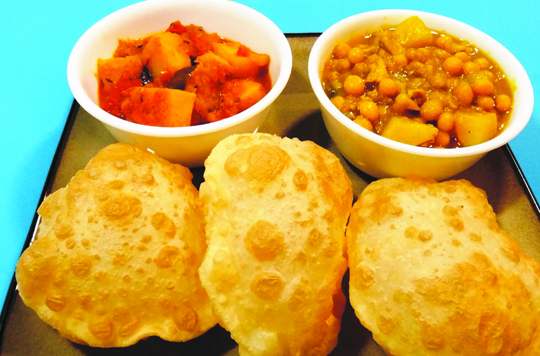Mama’s Punjabi Recipes: Puri (Deep Fried Puff Bread)
There is one type of fried bread that elicits great excitement because it is a cross between an appetizer and a meal, but can be eaten as either. You could call it a snack, but puris (deep fried puff bread) can be eaten for breakfast (with aloo sabzi), lunch (with kale channe), dinner (with different sabzis) and even dessert (with halva).
Puris are those wonderfully light, golden brown puffed, usually four-inch round pieces of fried bread that, if you aren’t careful, you can eat a dozen of in one sitting when they come hot off the frying kadai (wok).
The word puri derives from the Sanskrit word purika from pur or filled. Puris are usually made of atta (wheat flour finely milled), but some make them using maida (refined and bleached white flour) and atta mix. The dough is a little harder than the one made for regular rotis (flat bread).
While frying puris, the moisture in the dough expands in all directions so that it puffs up like a round ball. A punctured puri does not puff because the steam escapes as it cooks. Some people put a little oil in the dough as they believe it will make the puri crispy but that in fact, it makes the puris hard after they have cooled down.
Punjabi usually eat puris with kale chole (black chickpeas), but these are not to be confused with the larger and softer bhature (deep fried soft bread) which is similar but bigger and also eaten the same way. Most often puris are eaten for breakfast or as a part of a ceremonial religious ritual. Uneaten puris can be kept wrapped in aluminum foil for 4 or 5 days and they will not go bad. If they are hard then warm them up in the microwave, and they become soft again.
Ingredients :
250 gm atta (wheat flour)
1 measure of pani (water) to make the dough soft
Vegetable oil to fry in
Directions:
1. Slowly add water to the flour and knead the dough till it has is semisoft.
2. Put the dough in a bowl, cover it with a light cloth and place it aside for 30 minutes to let it ferment a little.
3. Grease your palms with some oil so that the dough won’t stick and then break the dough into several 1-inch pieces. Roll them into balls and set aside.
4. In a kadai (deep skillet or wok), heat the oil up till it is very hot.
5. Roll the dough with a walan (rolling pin) till you form a 4-inch round patty. Roll all the patties out and keep to the side for frying.
6. Carefully slide the patty into the hot oil and then see if the patty starts to puff up and then turn slightly brown.
7. Repeat the steps and cook all the dough. As the puris come out, place them on paper towels on an inclined plate to soak up and drain the excess oil. Keep the heat on high until you are done with cooking.
8. Serve hot with the chole, aalo sabzi or halva with your favorite garnishes.
MAMA’S TIP OF THE WEEK
HOW TO CHOOSE FRESH VEGETABLES
Shopping for fresh vegetables can often be a confusing task if you are not experienced in picking the right ones, especially if these are the seed variety. If you happen to select the ones that have too many seeds then you will waste a lot of the vegetable since the ripe seeds will have to be removed.
For kerelas (bitter gourd), bhindi (okra), ghia (bottle squash), kheera (cucumbers) and baingan (eggplant), france bean (green beans) choose pieces that are not too fat (which means too many seeds inside), but preferably long and firm. For shalgam (turnips), band gobi (cabbage) and mooli (daikon radishes), large pieces are not the best as they will be too ripe and hard; choose medium sized pieces instead.
Shakuntla Malhotra is a skilled cook of Punjabi dishes made in the old-fashioned style that she learnt as a young woman in her ancestral home in Lyallpur, India before it became part of Pakistan after the Partition in 1947. People have often admired her cooking for its simplicity and taste that comes with each mouthful. Even in her mid-eighties, she continues to cook daily and agreed to share some of her delectable Punjabi recipes.


